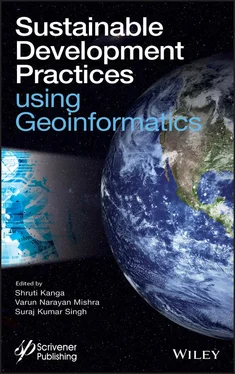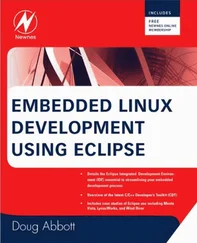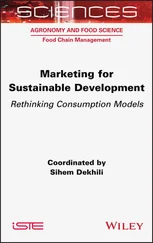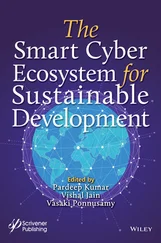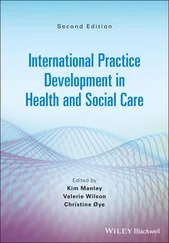Keywords:Urbanization, UHI, NDVI, LST
Urban land is primary resultant feature on the Earth surface, induced by human activities from centuries. Urban area is defined as the area having facilities of higher administrative departments in which most of the population belong to secondary and tertiary division, these segments comprises a city or a town, etc. (McGranahan, Satterthwaite, and International Institute for Environment and Development 2014). Urbanization can be simply defined as the conversion of any spatial entity from rural to urban with the help of technology and sustainable uses of resources (Datta 2007). Since ancient era, modification, and transformation of the geographical areas are steady, and great example of this is urban landform. World’s earliest industrial revolution took place in Britain in the 18th century, which caused the rural mass movement toward cities. This era was considered to be the footstep of urbanization. However, in India, the wind of urbanization was initiated by the Britishers, while India being once a domicile of British Empire. The modification in the settlements and settlement zone continue to vary till date, which commences urban sprawl (Narayan 2014).
In the phases of urban development, continuous changes on land surface are observed, from small houses to tall buildings, agriculture to industry, pervious surface to impervious (paved) surface, kaccha road to highway, etc. (Grimmond 1998; Gál and Unger 2009). The two most important controlling factors responsible for the development and also retreat of urban region are pull factors and push factors. With the rapid urban sprawl, it results in the increase of inhabitants with a balance of demand and supply. Along with the proliferation of the crowd toward a separate area, there is burgeoning demand of supply for the inhabitants, which further entice entrepreneurs. The urban sprawl cannot be controlled; hence, it appears as an interrelated network of a complex system. The socio-economic development of an urban area is an impact of migration that escalates the growth of urban society. The constant process of growth leads to urban spread and agglomeration, which is continually an ongoing process (Yeh and Li 2001).
The scope of application of “Remote Sensing and GIS” is widening day by day from cryosphere to biosphere to hydrosphere to atmosphere, etc. Subject to mankind, most of application parts are broadly used like study of land cover dynamics, spatial growth, trend analysis, rainfall monitoring, zoning of hazard risk assessment mapping, global climatic imbalance, atmospheric phenomenon, etc. (Wijeatne and Bijker 2006). Contemplating the urban application part, it is largely used in the fields of urban morphology structure, urban flooding, urban planning, ventilation mapping, urban climatic zones, urban pollution, urban population, urban growth modelling, etc. (Grimmond and Oke 1999; Gál and Unger 2009; Mirzaei 2015; Wong, Nichol, and Ng 2011). With the advancement in technologies, it is aimed to gather data from the underground and under water also. Various endeavors were done to discover the prototype of urban growth and examine the several spatial patterns of urban area with the help of various algorithms including geographical weighted regression, Sleuth model, multivariate regression, etc. In India, the urban growth scenario is changing rapidly and poses complexity in measuring urban growth parameters, but use of remote sensing and GIS techniques are becoming handy in to perform analysis on urban growth and its impact on natural vegetation and local surface air temperature.
Urban sprawl is a continuous process, which leads to decrease in the amount of green space and increase in the density of concrete garden of buildings (Capozza and Helsley 1989). To demarcate the consistency of vegetation canopy layer, NDVI (Normalized Difference Vegetation Index) is a very useful index (Bhandari, Kumar, and Singh 2012; Volcani, Karnieli, and Svoray 2005). The increase density of buildings is the major cause of increasing surface air temperature that is trapped by the building infrastructure (Unger, Sümeghy, and Zoboki 2001). From this point of view, the concept of Land Surface Temperature (LST) is inspired, which is the temperature of the near surface area within specified limit, but it is entirely different from atmospheric temperature. The LST is a new emerging concept in the field of remote sensing and it plays a key role in establishing an inter-relation between NDVI and LST (Deng et al ., 2018). The relationship between LST and NDVI ponders on the concept of surface temperature in cram-full areas (Yuan and Bauer 2007). From this point of view, the area can be delineated as a Heat Island as the core area of the city experiences relatively high temperature than the surrounding and rural areas. The domain of UHI can be easily detected using these two crucial indices. The urban area that is comparatively hotter than the surrounding area can be considered as a UHI (Tso 1996).
India is home of 1,210,193,422 people (Census of India, 2011) and having a population density about 382 persons/km 2, which represent a mass of population pressure on less amount of land. As a developing country, India is bound to see increase in urban area or converting land use into boundless built-ups. India is facing force of population toward urban areas and converting land use into boundless built-ups. Since independence, the growth rate of urban population is gradually rising and recorded 17.46% as per Census of India, 2011. Kolkata is one of the renowned metropolitan cities having the population density of approximately 24,000 persons/km 2(Census of India, 2011), one of the highest in the world. The suburbs (Barasat, Barracpore, Kalyani, Kashba, Rajarhat, etc.) are having density of almost 9,000 persons/km 2, which is increasing rapidly. Because Kolkata is having limited land, the suburbs are developing at faster pace than the core city from last few decenniums. Barasat city is adjacent to Kolkata; therefore, the branches of Kolkata city are expanding toward the outskirt areas at faster rate and that can be clearly estimated from the difference in 2001 and 2011 Census.
Barasat city is in the northern outer periphery of Kolkata city, in West Bengal, India, facing problems of unplanned urbanization in a short span of time after getting declared as district head quarter town within the jurisdiction of Kolkata Metropolitan Development Authority (KMDA). It has a total area of 31.41 km 2and extends between 88°27’ E and 88°31’E longitude and between 22°40’58” N and 22°44’44”N latitude ( Figure 1.1). There are 32 wards in Barasat municipality. The growth rate of population in this town is very high and approximates around 3.5% per year. As per the provisional reports of census of India, population of Barasat in 2011 is 283,443. Barasat has a population density of 9,023 persons/km 2.
1.3 Datasets and Methodology
1.3.1 Datasets
The satellite images of Landsat 5 TM for the year 2001, Landsat 5 TM for the year 2011, and Landsat 8 OLI and TIRS for the year 2017 were obtained from USGS official website and processed for analysis ( Table 1.1), and to quantify the changes due to urbanization. The datasets used for various analyses and for preparing different maps along with census data are listed in Table 1.1.
Landsat images of different time are very helpful for the analysis of land use and land cover change pattern and to measure the increase in urban built-up area (Song et al ., 2001). To meet the objectives of the study, the following procedures were done. Pre-processing is an essential step for removing the atmospheric noise and haze, which is there in the image due to atmospheric scattering of solar radiation due to atmospheric elements (Chander, Markham, and Helder 2009). Satellite images were classified using Maximum Likelihood classification algorithm because it gives better accuracy than other available techniques like box classifier, minimum distance to mean, etc., available in published literature (Lyon et al ., 1998; Reis 2008; Patidar and Sankhla 2015).
Читать дальше
